How to benchmark storage devices with Gnome Disk Utility
Gnome Disk Utility can play many roles. It can be a source of information for all storage devices, as well as a solution to back up and restore them from images. Gnome Disk Utility can also benchmark them to show you the actual performance of storage media. This may be a simple 2 or 3 click process, but many people don't know its existence.
Using Gnome Disk Utility benchmark the storage devices
- Install Gnome Disk Utility
- Choose what to benchmark?
- Actions that can be taken
- The graph is empty
- It takes more time to achieve accuracy
- Recording requires exclusive access
- It may take a while to complete
- Do not delay the cancellation!
Install Gnome Disk Utility
If you are using the GNOME desktop, you probably have Gnome Disk Utility installed on your computer. If not, provided that you use a Linux-based distribution of Debian, you can install it with the command:
sudo apt-get install gnome-disk-utility The application is accessible from Accessories> Drives menu or if you want to launch it from the terminal, enter:
gnome-disk 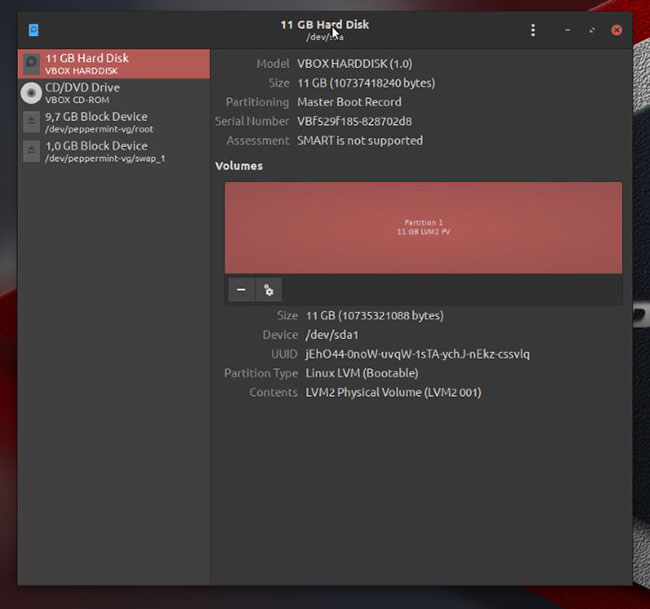
Choose what to benchmark?
The application doesn't gain any advantages in terms of interface, but does exactly what it does - no more, no less. In the left panel of the window, you can see a list of all storage devices connected to the computer. Selecting one of them will update the right part of the screen, showing the status of the selected device, as well as a graphical representation of its content.
In the example case, you only see one color used throughout, because the (virtual) hard drive in this case is relatively small, so the article used it as a single object without splitting. into individual partitions.

Actions that can be taken
Once you've selected a storage device, clicking the button with two gears will bring up a menu of actions you can perform on the device. You can delete partitions, finish checking or repairing the file system, retrieve or restore backups and benchmark selected storage media.
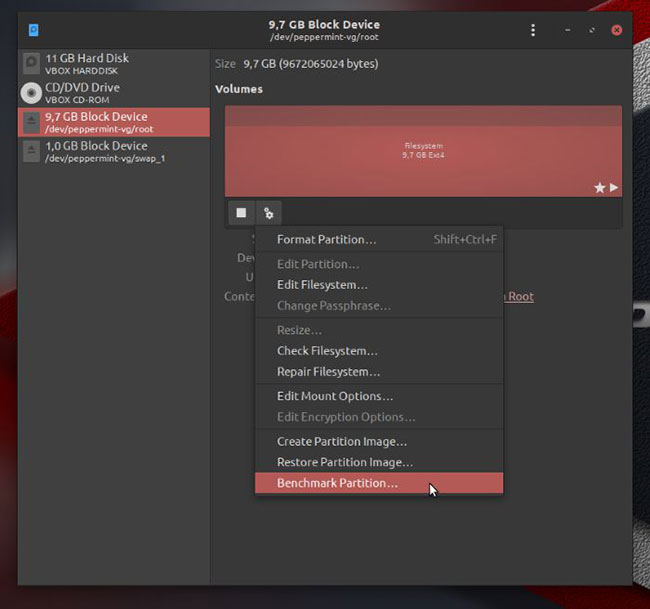
The graph is empty
After deciding whether you want to benchmark a device, a new window will appear on the screen and currently, it's empty. Click the 'Start Benchmark' button to start the benchmarking process.
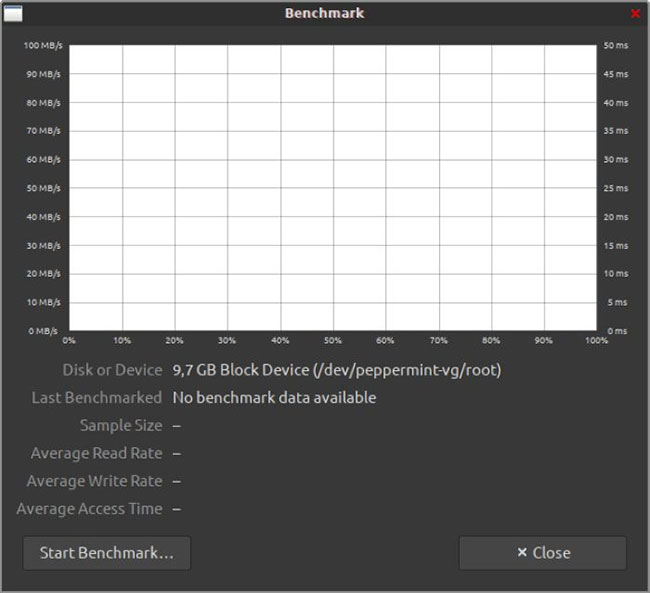
It takes more time to achieve accuracy
Before Gnome Disk Utility starts measuring the performance of storage media, you need to determine the level of detail you want the process to perform. In the Benchmark Settings window that appears, you can increase the values for more accurate results. The more accurate results you want, the longer it will take the benchmark process to complete.
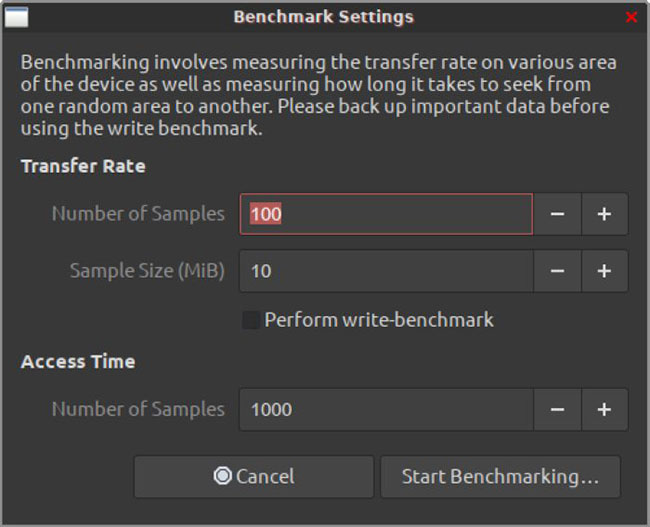
Recording requires exclusive access
The performance measurement process only assesses the ability of the device to read data. To measure device performance when recording, you need to enable the 'Perform write-benchmark' option . However, please note that for the application to write to the selected device, it is not mounted on the operating system. The application will be able to gain 'exclusive access' to the device for recording at work.
It is worth noting that unlike similar solutions, Gnome Disk Utility does not affect the contents of storage media during the writing test, so using this tool is considered safe. Of course, it is always a good idea to keep a recent backup of your data, especially before any processes work in any way on the storage media.

It may take a while to complete
Note that in order for the application to access a device and measure its performance, you will be prompted to grant it root access. Immediately after entering the password, Gnome Disk Utility will start refreshing the window you have previously seen with graphical representation and additional information about the performance of storage media.
If you have entered very high values related to the number of Gnome Disk Utility samples that will take into account or are benchmarking the performance of a 'gigantic' hard drive, this process can take a long time (in many cases up to few hours). Usually, if the storage media has no hardware problems, you don't have to wait too long to get an overview of its performance. A few minutes are more than enough to provide average values with relative reliability.
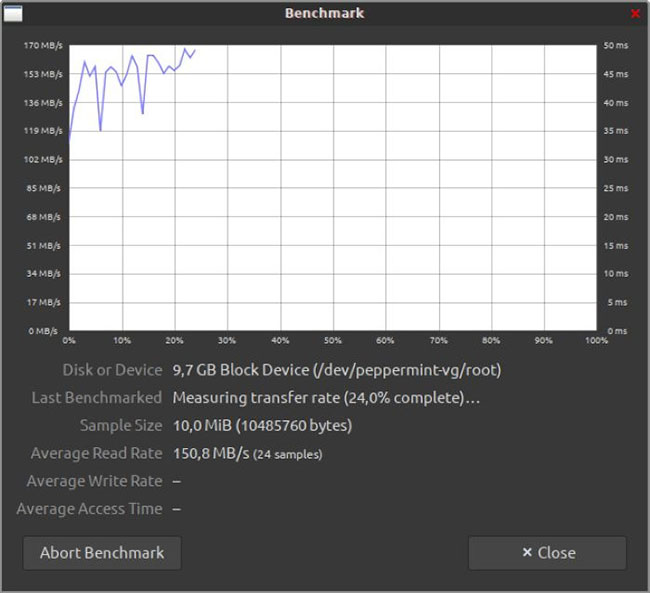
Do not delay the cancellation!
However, unfortunately, the application completes the measurements in turn, because if you try to measure many different things at the same time, that will affect the performance of the storage device. This means that if you click on the 'Abort Benchmark' or 'Close' buttons at the bottom of the window before the program completes the process, you get an overview of the first performance indicator: Average Read Rate.
For a more comprehensive view of the device's performance, you should wait or, if the procedure takes too long, cancel it, go back and reduce the values that determine the granularity of the benchmark process. , then restart the process.
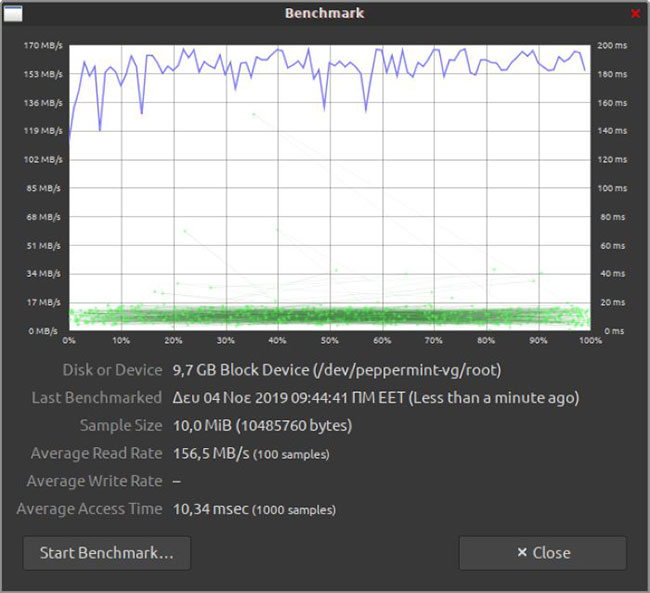
This way, you will get both Average Access Time and Average Write Rate values, if you have the option turned on to perform a writing benchmark.
You should read it
- How to work with workspace in GNOME
- How to disable automatic workspace in GNOME
- How to use GNOME 45's new Activities indicator
- The 10 best features in GNOME 45
- How to Change Themes on Ubuntu with Gnome Tweak Tool
- Should I use Linux desktop KDE or GNOME?
- How to use Disk Utility to repair the hard drive and decentralize the drive
- How to Install Gnome on Arch Linux
May be interested
- What is a disk signature? Fix disk signature conflict error
 a disk signature is a unique, defined number of a hard drive or data storage device, stored as part of the master boot record (mbr).
a disk signature is a unique, defined number of a hard drive or data storage device, stored as part of the master boot record (mbr). - About the Diskpart command line utility
 this article will introduce you to the diskpart utility. you can use this utility to set up a storage configuration using a script, a remote control session, or through a different command window. diskpart helps enhance the graphical user interface of disk administrator.
this article will introduce you to the diskpart utility. you can use this utility to set up a storage configuration using a script, a remote control session, or through a different command window. diskpart helps enhance the graphical user interface of disk administrator. - How to use Disk Quota to limit Windows storage capacity
 disk quota is a great way to control storage space on your computer, ensuring that users cannot use more storage space than is allocated.
disk quota is a great way to control storage space on your computer, ensuring that users cannot use more storage space than is allocated. - Disk Management access in Windows 7 and Windows 8
 this article shows you how to access and work with disk management for both windows 7 and windows 8. disk management is a powerful hard disk space management tool in windows. not only that, it also manages all other storage devices such as: floppy disks, flash disks ...
this article shows you how to access and work with disk management for both windows 7 and windows 8. disk management is a powerful hard disk space management tool in windows. not only that, it also manages all other storage devices such as: floppy disks, flash disks ... - How to work with workspace in GNOME
 workspace or virtual desktop is a major feature of the linux desktop. it has been around for a long time and is available for almost every linux window manager. read on to learn how to work with multiple workspaces in gnome.
workspace or virtual desktop is a major feature of the linux desktop. it has been around for a long time and is available for almost every linux window manager. read on to learn how to work with multiple workspaces in gnome. - The 10 best features in GNOME 45
 the gnome 45 release is attracting a lot of attention, and the good news is that it's available in ubuntu 23.10, which launches next month.
the gnome 45 release is attracting a lot of attention, and the good news is that it's available in ubuntu 23.10, which launches next month. - How to Change Themes on Ubuntu with Gnome Tweak Tool
 the gnome tweak tool is an extension of the gnome shell that can be used to modify the gnome interface. ubuntu now uses the unity desktop environment, so in order to use gnome tweak tool, you should use the [https://ubuntugnome.org/ ubuntu...
the gnome tweak tool is an extension of the gnome shell that can be used to modify the gnome interface. ubuntu now uses the unity desktop environment, so in order to use gnome tweak tool, you should use the [https://ubuntugnome.org/ ubuntu... - How to Disable RAID
 redundant array of independent disks (raid) is a storage volume management technology that can be used to enhance a computer system's storage capabilities by incorporating multiple disk drives into a single drive. certain situations may...
redundant array of independent disks (raid) is a storage volume management technology that can be used to enhance a computer system's storage capabilities by incorporating multiple disk drives into a single drive. certain situations may... - How to change icons in Gnome 3
 if you don't like the current files and folders in gnome, you can use a different theme icon. you can change any file or folder icon into a custom icon.
if you don't like the current files and folders in gnome, you can use a different theme icon. you can change any file or folder icon into a custom icon. - Back up the boot drive using Disk Utility
 this tutorial will show you one of the many methods available to backup your boot drive. this process usually takes half an hour to 2 hours or more, depending on the size of the data you are backing up.
this tutorial will show you one of the many methods available to backup your boot drive. this process usually takes half an hour to 2 hours or more, depending on the size of the data you are backing up.









 How to install Freeoffice in Linux
How to install Freeoffice in Linux Basic guide to Nano editor
Basic guide to Nano editor How to install and use a vulnerability scanner in Linux
How to install and use a vulnerability scanner in Linux 11 df commands in Linux (with example)
11 df commands in Linux (with example) Minimum hardware requirements for installing FreeBSD
Minimum hardware requirements for installing FreeBSD How to add simple launcher dashboard on LXDE
How to add simple launcher dashboard on LXDE